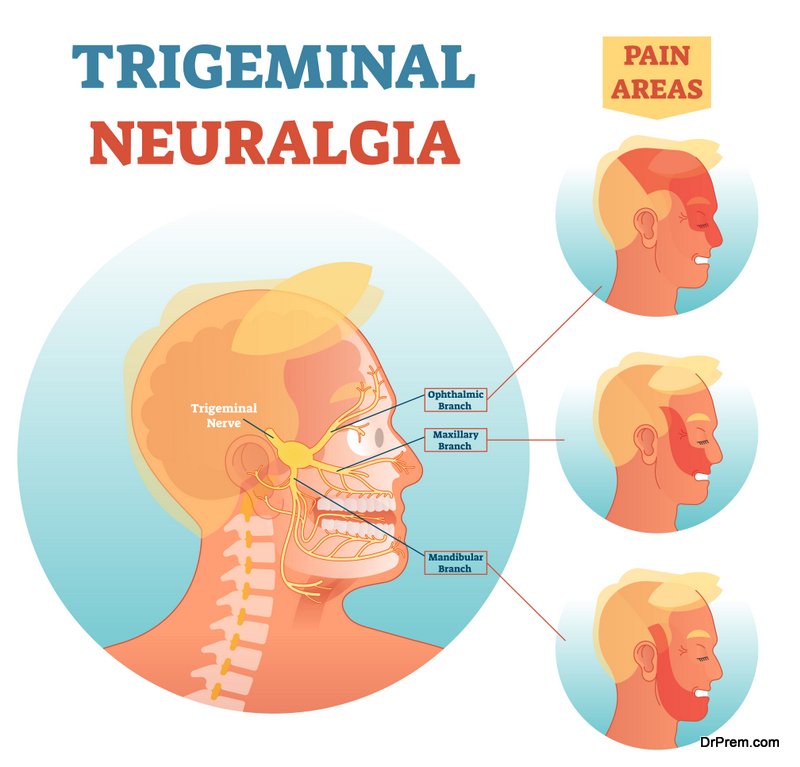Trigeminal neuralgia is a chronic massive pain attack, especially experienced in the face in the form of intense, electric-shocks. The pain attack can be triggered without any prior notification or warning signs in multiple yet specific areas of the face. Although experts are still figuring out the exact cause and the risk factors associated with the chronic pain, studies have investigated that blood vessel leading to the particular area is found to be compressed, identified to be responsible for trigeminal neuralgia.
What is Trigeminal Neuralgia?
 Trigeminal Neuralgia is identified to be as the fifth cranial nerve, starting from the brainstem behind the ear; and is further categorized into three branches in order to supply the sense of touch and movement to different locations of the face, and can be noted as:
Trigeminal Neuralgia is identified to be as the fifth cranial nerve, starting from the brainstem behind the ear; and is further categorized into three branches in order to supply the sense of touch and movement to different locations of the face, and can be noted as:
- Ophthalmic trigeminal nerve can provide sensation to the forehead and the eyes.
- Maxillary part of trigeminal nerve can be directed towards the cheek, lip and the roof of the mouth.
- A mandibular portion of the nerve provides sensation to the jaw, lower lip and also to the muscles involved in the biting, chewing as well as swallowing part.
The irritation related to Trigeminal nerve may lead to its intense pain due to unusual compression and blockage of the passage of oxygenated blood. The pain associated with the issue is in a repeated motion, lasting for an hour or so. It should also be noted that the pain associated with the trigeminal nerve is progressive and disastrous.
Symptoms of Trigeminal Nerve
 A patient suffering from Trigeminal Neuralgia typically complains about a needle pricking pain or sensation into specific areas of the face, which can progressively aggravate and become unbearable at times. The episode can be triggered at any point of time in a day, may be due to initiation of different activities. The trigger zone or the sensitive areas of the face are variable in different patients. In general, the reported list of zones on the face may include the area near nose, lips, eyes, ears and inside the mouth.
A patient suffering from Trigeminal Neuralgia typically complains about a needle pricking pain or sensation into specific areas of the face, which can progressively aggravate and become unbearable at times. The episode can be triggered at any point of time in a day, may be due to initiation of different activities. The trigger zone or the sensitive areas of the face are variable in different patients. In general, the reported list of zones on the face may include the area near nose, lips, eyes, ears and inside the mouth.
Patients may reportedly avoid activities such as chewing, talking, drinking as well as brushing their teeth. The medical specialist has listed typical trigeminal neuralgia symptoms as:
- Experienced a stabbing pain only on the one side of the face.
- The pain can last up to several days, months or years; followed by their remission
- Over the period of time, the frequency of the painful attack is increased and may at times become disabling.
Prevalence and incidence of Trigeminal Neuralgia
 Every year around 1,50,000 people are being diagnosed with the issue. However, there is no specified age limit so far, however, the reported cases have suggested an average age of 50. As per further report proposed by The National Institute of Neurological Disorders and Strokes, more women are being suffered with the issue than men.
Every year around 1,50,000 people are being diagnosed with the issue. However, there is no specified age limit so far, however, the reported cases have suggested an average age of 50. As per further report proposed by The National Institute of Neurological Disorders and Strokes, more women are being suffered with the issue than men.
Causes associated with Trigeminal Neuralgia
 So far limited cases have been reported against the suicidal disease and hence the risk factors associated with the same need to be evaluated. Further evaluation on the same confirmed that the protective insulating material covering trigeminal nerve is damaged or degenerated in a progressive manner, due to a number of factors either environmental and/or genetic. With the progressive deterioration, the neuronal surface is exposed to the outer shock and resistance, further sending abnormal messages to other vital parts of the face.
So far limited cases have been reported against the suicidal disease and hence the risk factors associated with the same need to be evaluated. Further evaluation on the same confirmed that the protective insulating material covering trigeminal nerve is damaged or degenerated in a progressive manner, due to a number of factors either environmental and/or genetic. With the progressive deterioration, the neuronal surface is exposed to the outer shock and resistance, further sending abnormal messages to other vital parts of the face.
Risk factor analysis done so far reveals that women with a previous history of hypertension and other genetic disorders, such as multiple sclerosis are at a greater risk of Trigeminal Neuralgia. Specialists have also tried to evaluate the typical causes of Trigeminal neuralgia and confirmed that the neuronal pressure can damage a certain part of the myelin sheath leading to the issue.
Diagnosis Associated with Trigeminal Neuralgia
 The structural changes pertaining to trigeminal nerve can be viewed through medical resonance spectroscopy. Further to which, causes specified health such as hypertension, multiple sclerosis etc. can be the reasons, the imaging system would be able to reveal a picture of a compressed nerve.
The structural changes pertaining to trigeminal nerve can be viewed through medical resonance spectroscopy. Further to which, causes specified health such as hypertension, multiple sclerosis etc. can be the reasons, the imaging system would be able to reveal a picture of a compressed nerve.
Certain other diagnostic tests can be specified by experts in order to help rule out other causes of facial numbness and difficulty.
When to seek expert medical advice?

If any of you are experiencing frequent, unbearable facial pain without any reason like dental issues, headaches etc. then it is certainly a time for you to get expert’s help for Trigeminal Neuralgia. A GP will try to evaluate the issue further depending upon the family history and previous disease history, and rule out the chances of other relevant issues; in order to confirm the diagnosis.
Although, it should be noted that diagnosing Trigeminal Neuralgia can at times be little difficult and can take a longer time to confirm.
Treatment associated with Trigeminal Neuralgia
 There are several steroidal medicines, such as carbamazepine, baclofen as well as phenytoin etc. that can be prescribed for Trigeminal Neuralgia. These drugs are responsible mainly for controlling unbearable pain associated with the issue. However, it should also be noted that there are possible side effects of these medicines, if taken for longer period of time such as depression, convulsion, double vision, drowsiness etc. and hence should be consumed intermittently. Many of these drugs have been reported for their toxic side effects like bone marrow suppression, kidney damage, liver damage etc. and hence, should be consumed under the expert’s guidance with proper doses.
There are several steroidal medicines, such as carbamazepine, baclofen as well as phenytoin etc. that can be prescribed for Trigeminal Neuralgia. These drugs are responsible mainly for controlling unbearable pain associated with the issue. However, it should also be noted that there are possible side effects of these medicines, if taken for longer period of time such as depression, convulsion, double vision, drowsiness etc. and hence should be consumed intermittently. Many of these drugs have been reported for their toxic side effects like bone marrow suppression, kidney damage, liver damage etc. and hence, should be consumed under the expert’s guidance with proper doses.
Other non-medical and surgical treatments
 If in case, medicines have proven to be non-effective for Trigeminal Neuralgia then several surgical procedures can help control pain associated with Trigeminal Neuralgia. These can further be categorized into:
If in case, medicines have proven to be non-effective for Trigeminal Neuralgia then several surgical procedures can help control pain associated with Trigeminal Neuralgia. These can further be categorized into:
- Open Cranial Surgery: Microvascular decompression is being identified as one of the ways to locate the trigeminal nerve root and the blood vessel responsible for its compression; through microvascular exposure of the area. Blood vessels once identified can be removed away from the nerve root through easy movement, in order to further allow nerve decompression. This results in faster recovery of the trigeminal nerve, by further reducing the sensitivity associated with it. However, the surgery for Trigeminal Neuralgia is also not without any risk, since the skull has to be open completely there is a risk of decreased hearing.
- Lesioning Procedures: These procedures are accomplished through the removal of pain causing nerve either through the application of heat or through the introduction of glycerol or through the insertion of a single, highly concentrated dose of ionizing radiation.
Conclusion
Overall, the benefits of surgeries should always be evaluated against the risk factors associated with the same. Although, surgical treatments are highly preferred for the large quota of patients suffering from Trigeminal Neuralgia, as they report considerable pain reduction post procedure.




